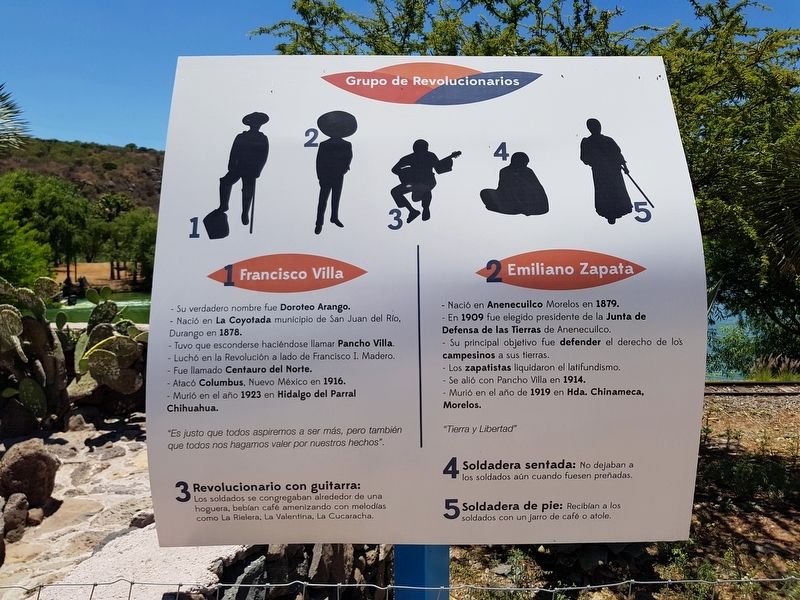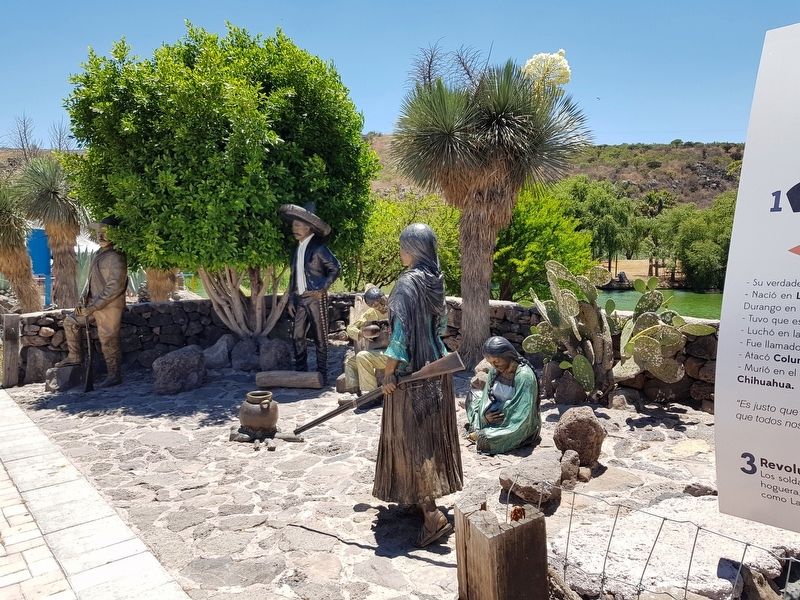Near Santa Rosa Jáuregui in Querétaro, Mexico — The Central Highlands (North America)
A Group of Revolutionaries
De Paseo por Querétaro
1 Francisco Villa
- Su verdadero nombre fue Doroteo Arango.
- Nació en La Coyotada municipio de San Juan del Río, Durango en 1878.
- Tuvo que esconderse haciéndose llamar Pancho Villa.
- Luchó en la Revolución a lado de Francisco I. Madero.
- Fue llamado Centauro del Norte.
- Atacó Columbus, Nuevo México en 1916.
- Murió en el año 1923 en Hidalgo del Parral Chihuahua.
“Es justo que todos aspiremos a ser más, pero también que todos nos hagamos valer por nuestros hechos.”
2 Emiliano Zapata
- Nació en Anenecuilco Morelos en 1879.
- En 1909 fue elegido presidente de la Junta de Defensa de las Tierras de Anenecuilco.
- Su principal objetivo fue defender el derecho de los campesinos a sus tierras.
- Los zapatistas liquidaron el latifundismo.
- Se alió con Pancho Villa en 1914
- Murió en el año de 1919 en Hda. Chinameca, Morelos.
"Tierra y Libertad”
3 Revolucionario con guitarra: Los soldados se congregaban alrededor de una hoguera, bebían café amenizando con melodías como La Rielera, La Valentina, La Cucaracha.
4 Soldadera sentada: No dejaban a los soldados aún cuando fuesen preñadas.
5 Soldadera de pie: Recibían a los soldados con un jarro de café o atole.
A Group of Revolutionaries
1. Francisco Villa
His real name was Doroteo Arango. He was born in La Coyotada, municipality of San Juan del Río, Durango in 1878. When he went into hiding he began calling himself Pancho Villa. He fought in the Revolution next to Francisco I. Madero and was known as the “Centaur of the North”. He attacked Columbus, New Mexico in 1916. He died in 1923 in Hidalgo del Parral, Chihuahua.
"It is fair that we all aspire to be more, but also that we all make use of our deeds."
2. Emiliano Zapata
He was born in Anenecuilco, Morelos in 1879. In 1909 he was elected president of the Lands Defense Board of Anenecuilco. His main objective was to defend the right of peasants to their lands. The Zapatistas divided up many of the large plantations in the areas where they were active. He allied with Pancho Villa in 1914. He died in 1919 in Hacienda Chinameca, Morelos.
"Land and Freedom"
3 A revolutionary guitarist: The soldiers gathered around a bonfire, drinking coffee and entertaining themselves with melodies like “La Rielera”, “La Valentina” and “La Cucaracha”.
4 Seated ‘soldadera’ (female revolutionary soldier): They did not leave the soldiers even when they were pregnant.
5 Standing ‘soldadera’: They greeted the soldiers with a mug of coffee or a atole (a hot drink made of ground corn).
Topics. This historical marker is listed in these topic lists: Government & Politics • Patriots & Patriotism • Wars, Non-US • Women. A significant day of the year for for this entry is March 21.
Location. 20° 43.975′ N, 100° 27.06′ W. Marker is near Santa Rosa Jáuregui, Querétaro. Marker can be reached from Calle Melchor Ocampo just west of Independencia, on the left when traveling west. The marker is part of a series of markers near replicas of historic landmarks of Querétaro. The marker is along the northern shore of the large man-made lake at Parque Bicentenario. Touch for map. Marker is in this post office area: Santa Rosa Jáuregui QUE 76220, Mexico. Touch for directions.
Other nearby markers. At least 8 other markers are within walking distance of this marker. Teatro de la República (a few steps from this marker); Aqueduct of Querétaro (a few steps from this marker); House of the Corregidora (within shouting distance of this marker); Santa Rosa de Viterbo (about 90 meters away, measured in a direct line); Temple of the Santa Cruz (about 90 meters away); The Mission at Tilaco
(about 120 meters away); The Mission at Concá (about 150 meters away); Peña de Bernal (about 150 meters away). Touch for a list and map of all markers in Santa Rosa Jáuregui.
Credits. This page was last revised on June 28, 2019. It was originally submitted on June 28, 2019, by J. Makali Bruton of Accra, Ghana. This page has been viewed 108 times since then and 15 times this year. Photos: 1, 2, 3, 4. submitted on June 28, 2019, by J. Makali Bruton of Accra, Ghana.



